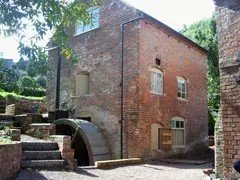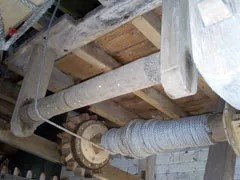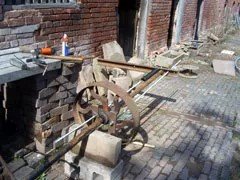Best viewed in landscape
Watermill Blog - Mill Expert
2nd September 2008
Tim Booth, our visiting mill expert, came to see how we are getting on this morning.

This picture gives you an idea of what he saw, all outside works virtually complete and looking very tidy.
The main purpose of his visit was to show us how he thinks the sack hoist used to work and how it was controlled. The hoist was started by dropping the gears into engagement without any form of clutch, just some slack in the hoist to give the gears a chance to settle before taking the strain. It was stopped by lifting the gears free of the crown wheel. All very crude and probably quite high maintenance!
With Martyn, Colin and Richard watching he went to some trouble to determine how the control ropes would have run so that the miller could control the hoist from any of the three floors.

We all came to the conclusion that there must have been some pulleys or rollers in strategic places, even though we can find no evidence of how they were fixed.
The picture shows the sack hoist windlass with the rope that connects to the main hoist on the garner floor above.
We did try Tim's ideas for controlling the hoist by turning the waterwheel like a treadmill and everything worked as expected. We need to make the control lines out of something a bit stronger than the bits of string we used for today's experiments before we dare try it under water power.
Work continued outside the mill as well, with John and Jonathan making good progress with the retaining wall outside the bottom door and Kim, Bob and Headley fixing the fence above the end of the culvert.

The line shaft pulley the at we want to move continues to defy us. Kim and Headley built a wheel puller from channel section steel and lengths of all-thread and succeeded in moving the pulley a short distance along the shaft.
The problem is that the pulley is keyed to the shaft with a taper key and this key will not move in the pulley boss although it is not gripping the shaft. Moving the pulley just drags the key along with it.
A great deal of heat and a lot of work with hammer and drift has moved the key about half an inch in the boss. We expected this to make the key come loose but it is still resisting all our attempts to remove it. We have even considered the possibility that the taper runs in the opposite direction but we can see no way in which it could have been assembled like that originally.
We have left the puller under tension in the forlorn hope that a couple of overnight changes in temperature will loosen something before we come back on Thursday. A frustrating end to an otherwise successful day.
Go to the next Watermill Blog entry
Go to the previous Watermill Blog entry
Learn how to Support Us
Return to our Home Page